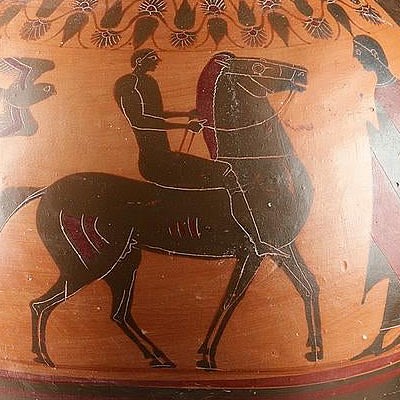Large Colima Pottery Standing Priest Figural Vessel
Lot 148c
About Seller
Artemis Gallery
686 S Taylor Ave, Ste 106
Louisville, CO 80027
United States
Selling antiquities, ancient and ethnographic art online since 1993, Artemis Gallery specializes in Classical Antiquities (Egyptian, Greek, Roman, Near Eastern), Asian, Pre-Columbian, African / Tribal / Oceanographic art. Our extensive inventory includes pottery, stone, metal, wood, glass and textil...Read more
Estimate:
$3,500 - $5,000
Absentee vs Live bid
Two ways to bid:
- Leave a max absentee bid and the platform will bid on your behalf up to your maximum bid during the live auction.
- Bid live during the auction and your bids will be submitted real-time to the auctioneer.
Bid Increments
| Price | Bid Increment |
|---|---|
| $0 | $25 |
| $300 | $50 |
| $1,000 | $100 |
| $2,000 | $250 |
| $5,000 | $500 |
| $10,000 | $1,000 |
| $20,000 | $2,500 |
| $50,000 | $5,000 |
| $100,000 | $10,000 |
| $200,000 | $20,000 |
About Auction
By Artemis Gallery
Jun 4, 2020
Set Reminder
2020-06-04 10:00:00
2020-06-04 10:00:00
America/New_York
Bidsquare
Bidsquare : Exceptional Antiquities, Asian, Ethnographic
https://www.bidsquare.com/auctions/artemis-gallery/exceptional-antiquities-asian-ethnographic-5185
An important one-day auction featuring museum-worthy examples of Egyptian, Greek, Roman, Etruscan, Near Eastern, Far East / Asian, Pre-Columbian, African / Tribal, Oceanic, Native American, Spanish Colonial, Russian, Fossils, Ancient Jewelry, Fine Art, so much more! Artemis Gallery info@artemisgallery.com
An important one-day auction featuring museum-worthy examples of Egyptian, Greek, Roman, Etruscan, Near Eastern, Far East / Asian, Pre-Columbian, African / Tribal, Oceanic, Native American, Spanish Colonial, Russian, Fossils, Ancient Jewelry, Fine Art, so much more! Artemis Gallery info@artemisgallery.com
- Lot Description
Pre-Columbian, West Mexico, Colima, Protoclassic Period, ca. 100 BCE to 250 CE. A hollow-built and highly burnished pottery figure of a sizable form depicting a priest or shaman standing atop delineated legs and covered in red-orange slip. The priestly man presents nude with a phallus hanging between his legs and wearing a discoid pectoral amulet atop his chest. He stands with a straight posture due in part to the enormous, serrated back panel and holds both arms up as if orating a prayer over those observing his gestures. His head is turned slightly to the left and exhibits almond-shaped eyes, a prominent nose above thin lips, tab-shaped ears, and a tapered hat with a protruding frontal brim. The top of the hat is cylindrical and doubles as the spout. Size: 9.375" W x 20.6" H (23.8 cm x 52.3 cm)
Colima, located on Mexico's southwestern coast, was part of the shaft tomb culture during this period, along with neighbors to the north in Jalisco and Nayarit. In this culture, the dead were buried down shafts - 3 to 20 meters deep - that were dug vertically or near vertically through the volcanic tuff that makes up the geology of the region. The base of the shaft would open into one or more horizontal chambers with a low ceiling. These shafts were almost always dug beneath a dwelling, probably a family home, and seem to have been used as family mausoleums, housing the remains of many related individuals. This is a figure made to be placed inside those mausoleums, perhaps to mediate between the worlds of the living and the dead.
Provenance: ex-dealer Richard Bellek collection, New York, New York, USA, listed in a 1965 inventory
All items legal to buy/sell under U.S. Statute covering cultural patrimony Code 2600, CHAPTER 14, and are guaranteed to be as described or your money back.
A Certificate of Authenticity will accompany all winning bids.
We ship worldwide and handle all shipping in-house for your convenience.
#155683Repairs to left leg, both arms, back panel, and both feet, with small chips and light adhesive residue along break lines. Loss to back of left foot as shown. Abrasions and nicks to limbs, body, back panel, and head, with fading to areas of original pigment, and light encrustations. Nice remains of original pigment and manganese blooms throughout.Condition
- Shipping Info
-
All shipping is handled in-house for your convenience. Your invoice from Artemis Gallery will include shipping calculation instructions. If in doubt, please inquire BEFORE bidding for estimated shipping costs for individual items.
-
- Buyer's Premium



 EUR
EUR CAD
CAD AUD
AUD GBP
GBP MXN
MXN HKD
HKD CNY
CNY MYR
MYR SEK
SEK SGD
SGD CHF
CHF THB
THB
















